Inspired by nature: How Organisational Biomimicry can enhance ways of working

What do you think of when you hear the words Organisational Development? For me, two key moments come to mind.
First when I was working in Hong Kong for JPMorgan, I was the head of learning and development, and our remit was to deliver Organisational Development & Design (OD&D). When I asked my boss in New York, she said that “Organisational Development is everything that is purposefully created for the optimal functioning of an organisation. It involves structure, systems, ways of working, patterns of communication, reward systems, role definitions etc.” That was the theory.
The second moment was in 2006 when I was fortunate enough to be invited to co-design and co-lecture an Organisation Development and Design MBA program at the Politechnico de Torino in Italy. They wanted the design and development to use nature as the inspiration, so we used the concept of Biomimicry, applying nature’s principles into the design of the program. It is pleasing to note that the MBA has grown into a fully operational program to which I was invited earlier this year to re-lecture on these concepts using Arowana, the company I currently work with as a case study. Some of this thinking is shared in this OD&D article.
Arowana is a global B Corp certified group that has a long-term commitment to building strong, sustainable businesses that will have a positive impact on economies, industries, and the people they employ. Our companies are in sectors such as electric vehicles (EV), renewable energy, education, and impact asset management.
The design developed has been a 10-year work in progress, in 2012, the question we wanted to see answered was:
What is a strong, flexible, and resilient structure that exists in nature that we can use throughout our internal structure as well as use as an operating manual for our member companies?
We looked at the beehive and the structure which forms the building blocks of any hive, the hexagon. If you look at a beehive, you will notice distinctly shaped bees operating in their own distinct roles and all around the hive, and the hexagon structure that holds the beehive together. This hexagon is known to be the strongest formation and has the highest degree of tessellation in nature.
Based on this, Arowana decided to build a culture around the hexagon concept. Within the organisation we tend to do things in ‘sixes’. On the surface, this may seem superficial but underneath it is the concept of tessellation to build depth, strength, and permanence in what we do.
For example, we have six key components in our talent lifecycle called the Arowana Performance Hexagon. It outlines the end-to-end talent workflow at Arowana and its portfolio companies. As I am a ‘bee’ working in the Talent Growth section of this Beehive, I’ll expand a bit more on this hexagon.
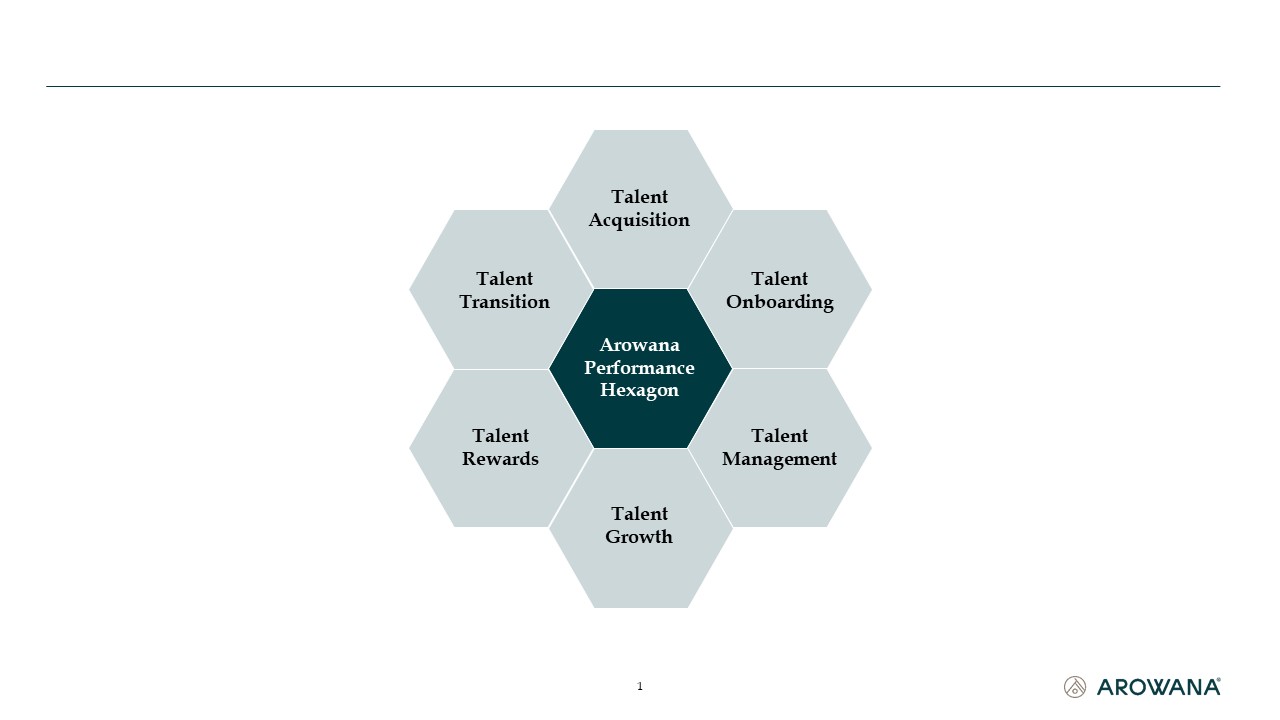
The Arowana Performance Hexagon comprises of the following six processes:
-
1) Talent Acquisition Process (TAP)
-
2) Talent Onboarding Process (TOP)
-
3) Talent Management and Execution Process (TAM)
-
4) Talent Growth Process (TAG)
-
5) Talent Reward Process (TAR)
-
6) Talent Transition Process (TAT)
These processes follow the talent lifecycle in our company and each employee is briefed on this at the induction process. Each manager is trained to understand and – where necessary – move these processes forward.
The People and Performance team plays a key role in enabling all these processes to work for the organisation, globally. For each of these steps in the performance hexagon, we have a set of hexagons that describe the specific underlying process in more detail. Let us look at a few examples.
The Arowana Talent Acquisition Process ™
The Arowana TAP process has been informed and adapted based on the NY Times Best Seller WHO by Geoff Smart and Randy Street.
Step 1: Completing the Talent Scorecard (TS)
The TS is Arowana’s blueprint for success as it links each position in the organisation to the overall strategy into execution steps and measurements. It describes in clear and measurable terms what the candidate needs to accomplish. This is not a job description as it also sets out the OKRs (Objectives and Key Result Areas) that are SMART (Specific, Measurable, Attainable, Relevant and Time-based) as well as the job-specific and organisation wide competencies required for success.
Step 2: Sourcing Candidates
Most companies use a combination of LinkedIn Recruiter and recruitment agencies to fill job vacancies. We do this and we also systematically scout for talent to build a network of talent as potential future hires. This ensures we have a high-quality talent bench of people that we already know and have been following their career prior to them joining.
Step 3: Screening Candidates
Hiring the right candidate can be time consuming, hence, to screen candidates we have a short 30 min screening interview, which uses a structured and consistent set of questions to cull ‘B’ and ‘C’ players out. Where necessary we conduct a profile assessment and/or a skills assessment test, this means that only candidates that stand out go to the next step.
Step 4: The WHO and Focused Interviews
The WHO interview uncovers patterns to match the position’s Scorecard. It is at the core of our TAP process and is based on the NY Times Best Seller WHO by Geoff Smart and Randy Street.
The Focus interviews are used to hone-in on the OKRS and competencies of the Scorecard to uncover more data if required.
Step 5: Selecting the ‘A’ Player
As a direct follow-on from Step 4, our HR team assembles a TAP Report which contains all the details of the recruitment process, the results from the Talent Scorecard and a recommendation. We have a panel decision making process. The HR Council reviews the data collected knowing that ‘A’ players have more than 90% of Skill & Will for the job. The TAP report is complemented with reference interviews and with a personality assessment (we use Hogan). We also conduct RISQ audits based on the person’s seniority to see if there is any other information we need to take into consideration.
Step 6: Selling – Locking in our A Player
This last step is crucial to the entire process. This is where we are confident that the candidate is the ‘A’ Player that is the best for the role. It is a courtship to woo the candidate, have them accept the offer and confirm to them that that their best career path is with Arowana. It is also the launch-pad for the Onboarding and Induction of the candidate.
We have found that the unique selling point of Arowana is that a successful recruitment is not the end goal, it is in fact the first step in our employees’ transformation into cross-trained, entrepreneurial thinkers, who are given latitude to forge their own path and influence the direction of the company within our purpose-driven framework.
As a B Corporation we value our team as an integral part of us projecting Arowana's purpose of growing sustainable businesses that deliver on the triple bottom line of people, planet, and profit. The Arowana TAP is constantly evolving and improving. The senior HR team are continually searching for options to further streamline and optimise the recruiting pipeline. For example, the Hogan personality assessments were recently introduced, as it allows for a hiring-focussed personality assessment.
At Arowana we don’t do strategy without execution. We also don’t do leadership without management. – Kevin Chin CEO and Founder
The Arowana Talent Onboarding Process ™
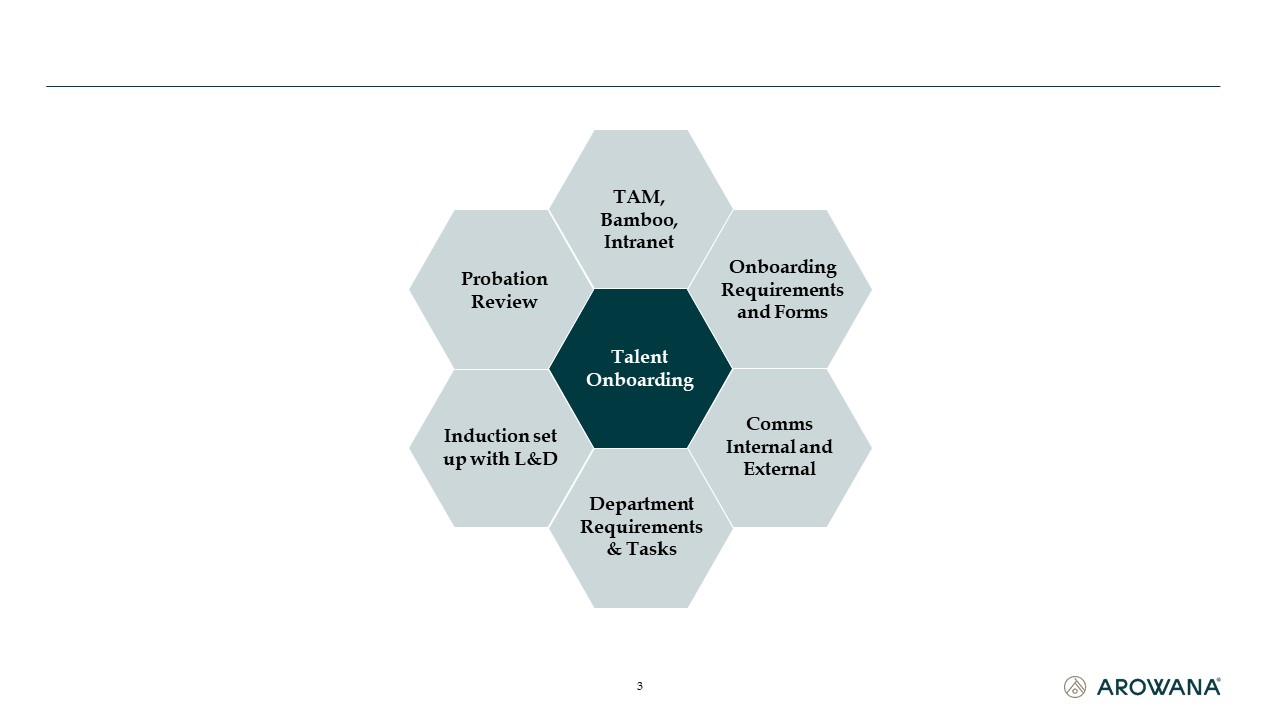
Again, here there are six clear steps that are followed for each new talent that enters the organisation. We see the TAP and the TOP processes very much as an end-to-end process which starts with the job vacancy and ends the day the probation is over.
In the Onboarding process alone, there are about 100 individual steps that HR and other departments execute in order to make the talent integration into our culture as seamless as possible. We go into this detail as we appreciate starting a new job in a new company is an important undertaking, hence, welcoming our new joiner into the company and helping them assimilate into the Arowana culture as much as possible is important to us.
However, we do sometimes make hiring mistakes, and we continuously learn from them, hence, debriefing from our mistakes is a crucial part of our culture to keep improving our processes.
Let’s now have a look at the Talent Execution hexagon
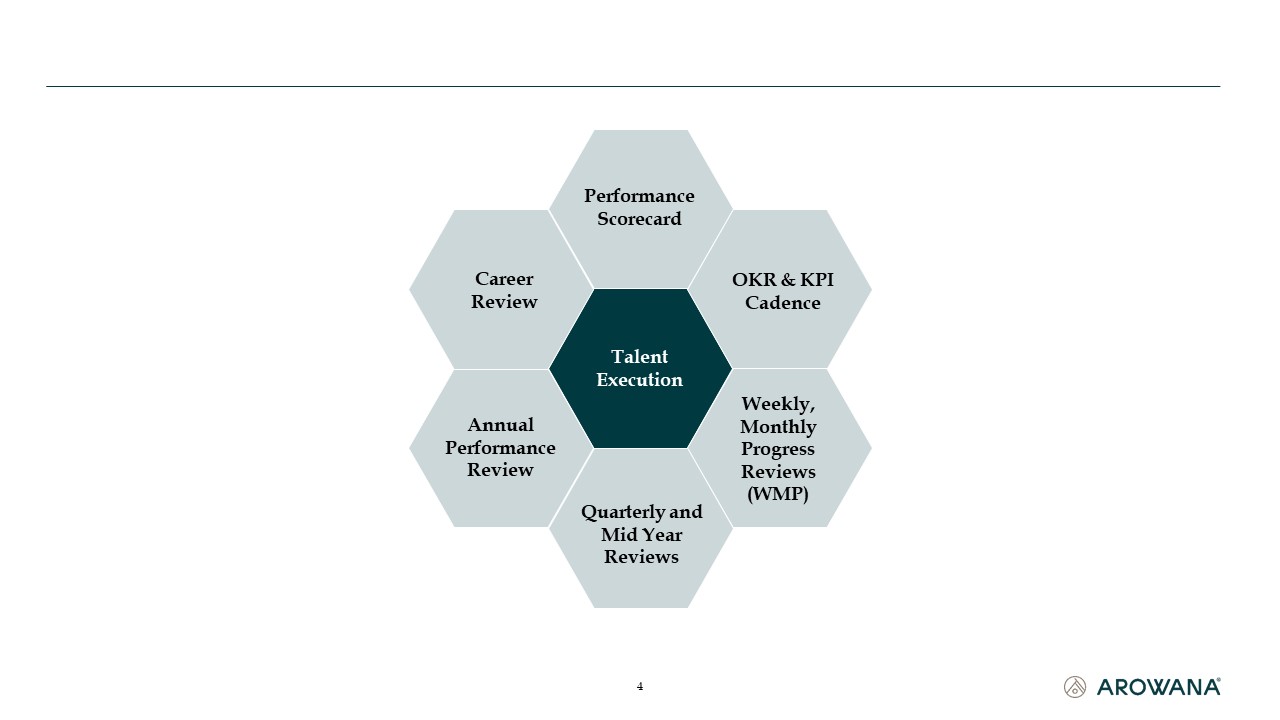
As we indicated before, every job has a Performance Scorecard attached to it. This document sets out in clear terms what is expected from the “A” player that will fill this position.
It has the Mission, the Objectives, and the Key Results or Key Performance Indicators for each of the Objectives, as well as the critical competencies for the position. The Performance Scorecard is the ideal document needed to manage the position on a year-to-year basis.
We work with a yearly and quarterly OKR/KPI cadence which is religiously reviewed every week during an 8-minute conversation with the person’s direct line manager. There are also monthly coaching sessions built into the cadence as well as Quarterly and Mid-Year reviews. For all Directors, these quarterly reviews are presented at the Circle of Leadership, so each director shows accountability for their Objectives.
When it comes to career progression, Arowana has a detailed career ladder in place with skills and experience requirements that an employee would need to meet in order to be considered for a promotion to the next level. This in totality makes up the Talent Execution hexagon.
Finally, I’d like to deep dive into the Arowana Talent Growth Hexagon.
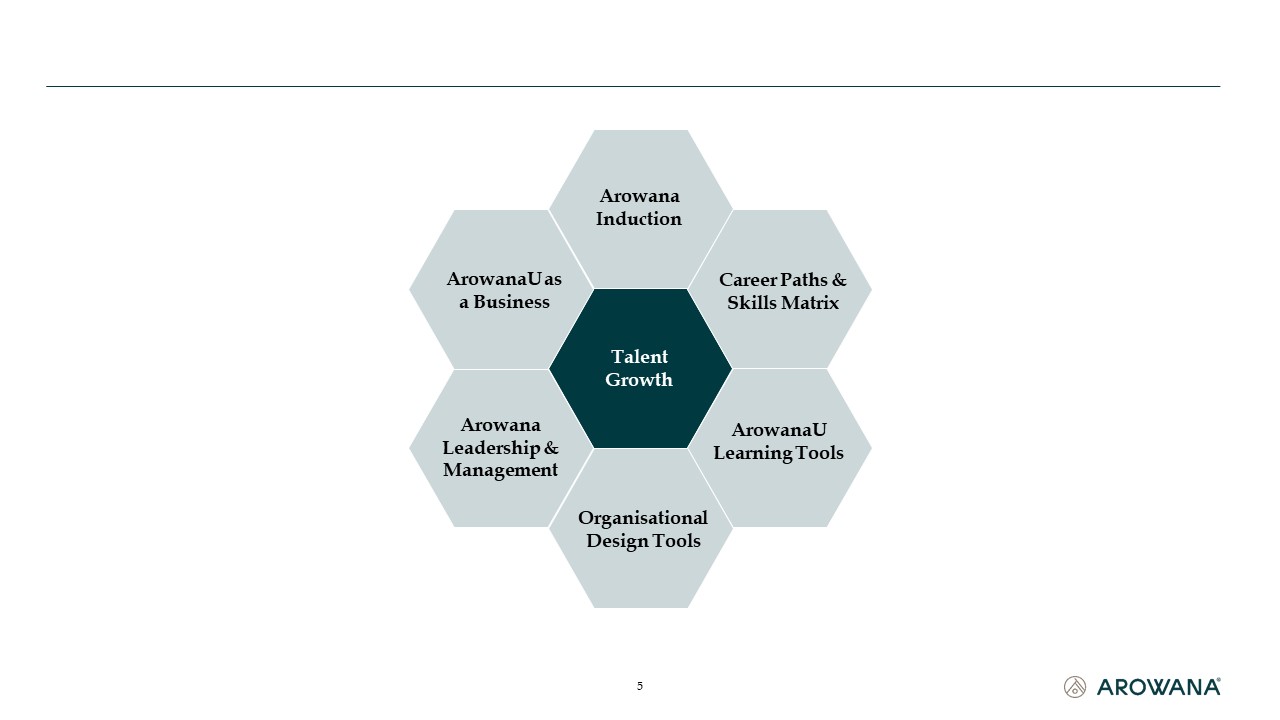
For this part of the beehive structure, we at the ArowanaU have gone a few levels deeper to ensure that all aspects of the Talent Growth process are documented and replicable. We use a variety of technology tools to automate each of the sub-processes as much as possible. For the Induction process for example we use Moodle as our Learning Management System, and we use SharePoint as our Content Management System.
We continually develop training programs from the massive library of content that has been developed over the last 10 years. We keep recordings of every presentation made at our quarterly Circle of Leadership which we supplement with research white papers and loads of proprietary insights. This allows us to design and present meaningful courses that are relevant and provide insight and foresight. Currently we’re working on highlighting key Leadership aspects into a 3-part course on VUCA leadership.
We’ve also developed an in-house Talent Acquisition course – which frankly we think would have a fair bit of relevance in many organisations, as well as a course on how to ScaleUP, FixUp or StartUp a company. It’s based on our insights and learnings acquired over the years in managing a variety of companies.
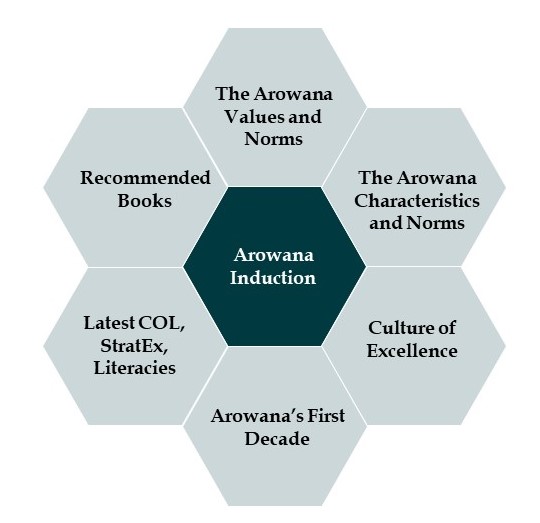
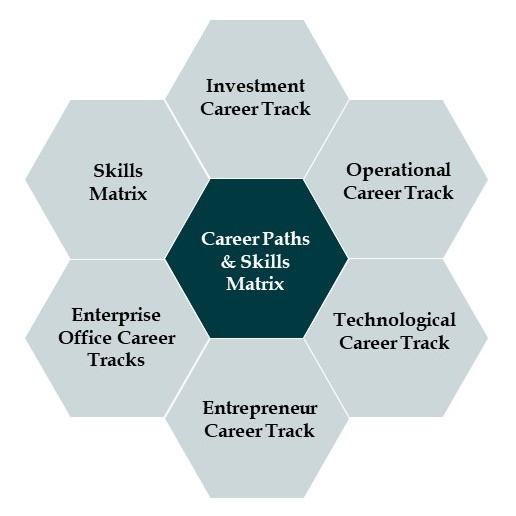
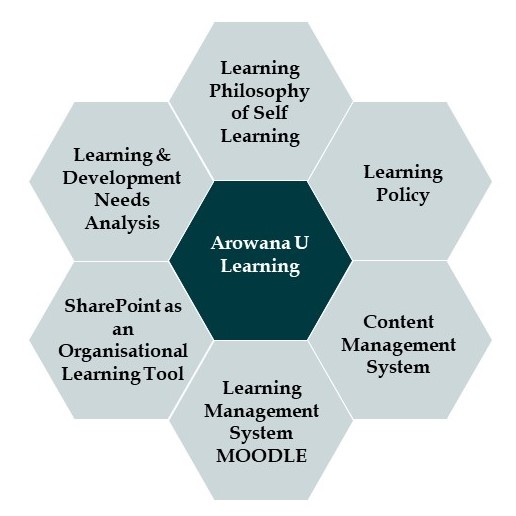
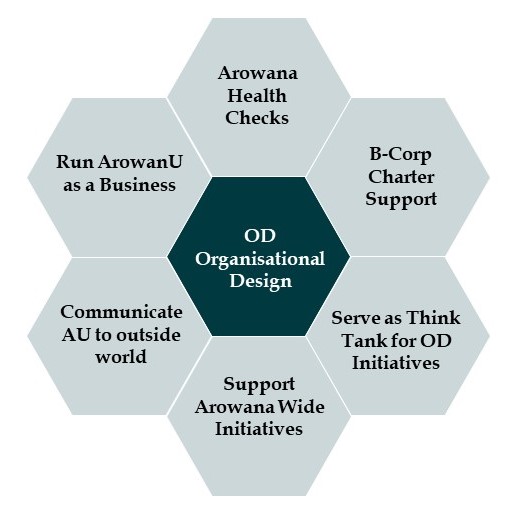
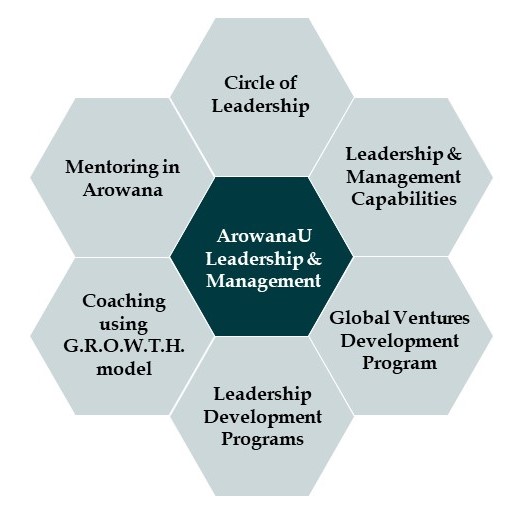
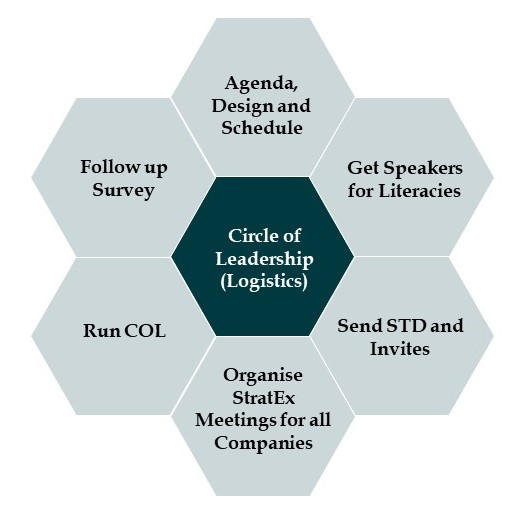
As a function within the organisation, ArowanaU goes a lot deeper in each of these dimensions and thus provides a robust set of documents, processes, and data for Arowana to run this function way past its current incumbents.
We have only shown the tip of the iceberg in this article.
To summarise, we took the concepts from Biomimicry to find a nature-spired business model and replicated the beehive into our systems, what this enables us to do is replicate our processes and systems and to bring alignment and structure to for our people. However, the most important function of worker bees, is to protect the Queen Bee and to enable the Queen Bee to produce more eggs to ensure the survival of the beehive. We compare the Queen Bee to the Purpose of our organisation. All worker bees in Arowana work for the Purpose to manifest itself. That purpose is to Grow People, Grow Businesses and Grow Value.
If you’re interested in finding out more, please don’t hesitate to contact me at dirkr@arowanaco.com

















